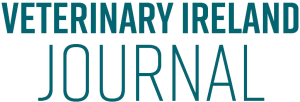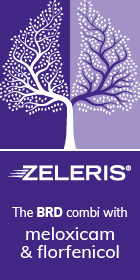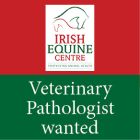Conformational eyelid disorders in dog breeds
Natural eyelid conformation is essential for normal function and health of the ocular surface. However, many modern dog types are deliberately bred for abnormal eyelid conformation associated with severe health and welfare issues. In this article, Dr Dan O’Neill MVB BSc(hons) GPCert(SAP) GPCert(FelP) GPCert(Derm) GPCert(B&PS) PGCertVetEd FHEA MSc(VetEpi) PhD FRCVS, Professor of Companion Animal Epidemiology, The Royal Veterinary College, presents an overview of the prevalence, demographic risk factors, and clinical management for conformational eyelid disorders in dogs under UK primary veterinary care within the VetCompass Programme during 2019
Natural eyelid conformation is essential for good function and health of the ocular surface1. The most important conformational eyelid disorders are entropion, i.e., inversion of the eyelid margin, and ectropion, i.e., eversion of the eyelid margin, or combinations of both1,2. The severity of entropion and ectropion may be influenced by several factors including the length of the palpebral fissure, conformation of the skull, the orbital anatomy, sex, excessive facial skin folds, and heavy ears2-4. Entropion often accompanies ectropion in macroblepharon when the lateral portion of overly long and sagging ectropic eyelid margins invert1, 2. Entropion and/or ectropion are presumed to be inherited polygenically in several dog breeds1-3, 5.
Both entropion and ectropion are considered as disorders that threaten the welfare and retention of eyesight of affected individuals, due to the discomfort and inflammation associated with the hair contact on the densely innervated ocular surface and also from painful corneal ulceration ranging from superficial ulcers to perforation of the globe with the risk of loss of vision or loss of the globe 1,2, 6-10.
There has been dramatically rising demand over the past two decades for some breeds defined by their extreme conformation, especially brachycephaly, leading to the so-called ‘brachycephalic crisis’ 11. The International Collaborative on Extreme Conformations in Dogs (ICECDogs) defines extreme conformation in dogs as “a physical appearance that has been so significantly altered by humankind away from the ancestral natural canine appearance that affected dogs commonly suffer from poor health and welfare, with negative impacts on their quality and quantity of life”12.
This study aimed to report the prevalence, breed and breed-related risk factors, and commonly-used clinical management approaches in dogs under UK veterinary primary care using anonymised veterinary clinical data from the VetCompass Programme13.
This article is a summary of a fuller report:
O’Neill, D.G., Mustikka, M.P., Brodbelt, D.C., Church, D.B. and Vaattovaara, V. (2025) ‘Conformational eyelid disorders in dogs under primary veterinary care in the UK - Epidemiology and clinical management’, PLoS One, 20(6), e0326526, available at:
http://dx.doi.org/10.1371/journal.pone.0326526.
Methods
This cohort study population included 2,250,417 dogs under primary veterinary care at clinics participating in the VetCompass Programme during 2019. Ethics approval was obtained from the RVC Ethics and Welfare Committee (reference SR2018-1652). Conformational eyelid disorder cases had a final diagnosis of entropion or ectropion (or synonym) at any date from January 1, 2019 to December 31, 2019. Case-finding involved initial screening of all study dogs for candidate conformational eyelid disorder cases using search terms of the clinical notes such as entrop, entropion~2, holtz. The clinical notes of a random sample of candidate animals were manually reviewed and additional clinical management information extracted for confirmed conformational eyelid disorder cases.
Dogs were categorised by breed, ear carriage (erect, e.g., German Shepherd Dog; semi-erect, e.g., Rough Collie; v-shaped drop, e.g., Hungarian Vizsla; pendulous, e.g., Basset Hound; and unspecified), coat length (short, medium, long, uncategorised), skull shape (dolichocephalic, mesocephalic, brachycephalic, uncategorised), brachycephalic severity (mild, moderate and severe), spaniel type (spaniel type purebred, non-spaniel type purebred, spaniel type designer crossbred, non-spaniel designer crossbred, general crossbred) and Kennel Club breed group (Gundog, Hound, Pastoral, Terrier, Toy, Utility, Working, non-Kennel Club recognised)11, 14-17. Adult bodyweight defined the median of all bodyweight (kg) values recorded for each dog after reaching 18 months old. Age (years) was defined for each dog on December 31, 2019. Results for clinical management were reported descriptively. Risk factor analysis used multivariable binary logistic regression modelling. Statistical significance was set at P < 0.05.
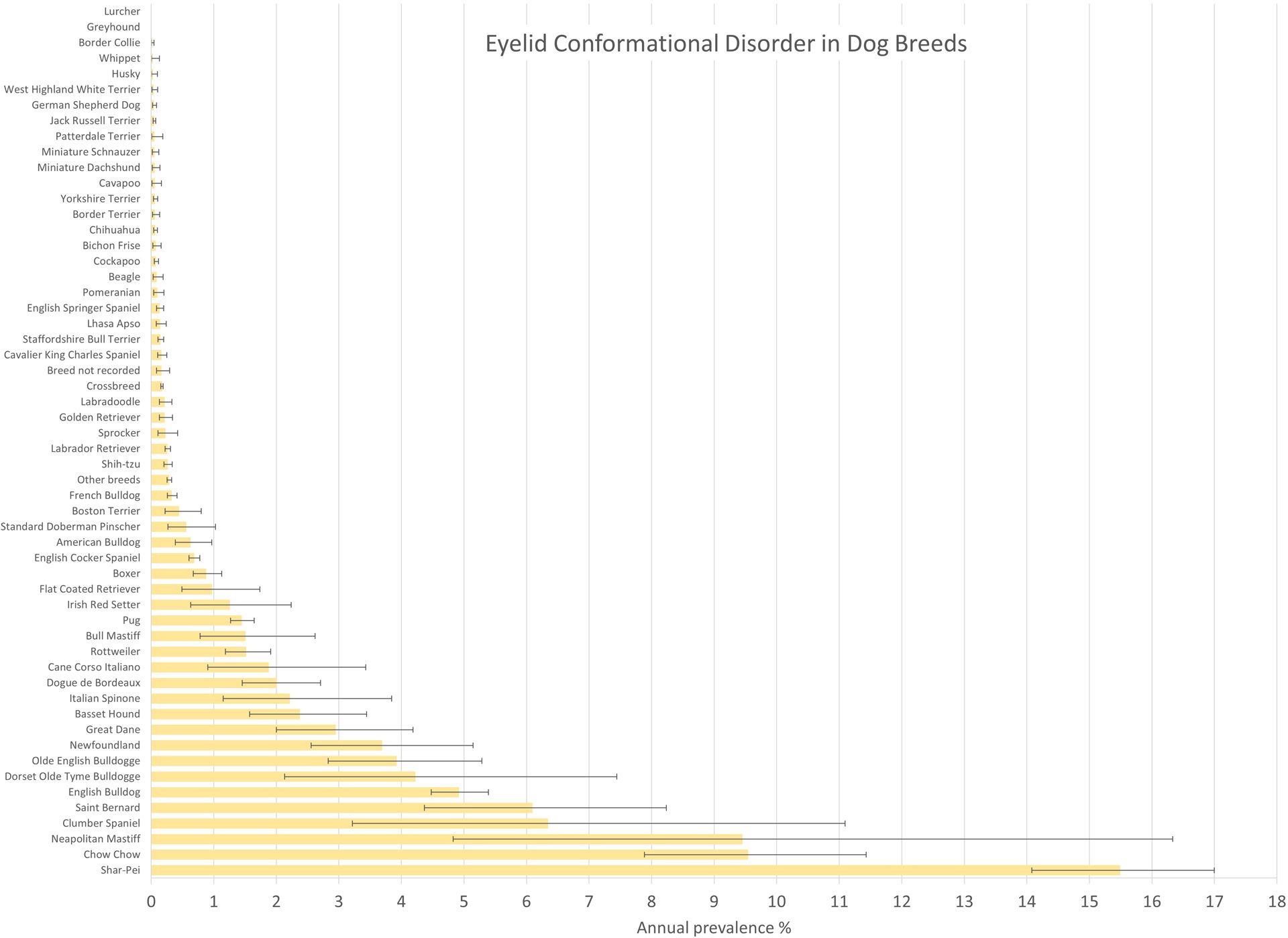
Figure 1: Annual prevalence ( per cent) of conformational eyelid disorder in dog breeds under primary veterinary care in the VetCompass Programme in the UK in 2019. The horizontal bars represent 95 per cent confidence intervals.
Result
Descriptive results - conformational eyelid disorders overall
Text searches of the 2,250,417 dogs yielded 13,423 candidate cases of conformational eyelid disorder with some evidence of entropion and/or ectropion in 2019. Manual checking of a random sample of 5,000/13,423 candidate cases confirmed 3,029 conformational eyelid disorder cases during 2019. After accounting for subsampling, the annual prevalence for conformational eyelid disorder in dogs overall was 0.36 per cent (95 per cent CI: 0.35-0.37). Breeds with the highest annual prevalence for conformational eyelid disorder overall were Shar-Pei (15.49 per cent, 95 per cent CI 14.08-17.00), Chow Chow (9.55 per cent, 95 per cent CI 7.88-11.43), Neapolitan Mastiff (9.45 per cent, 95 per cent CI 4.83-16.33), Clumber Spaniel (6.34 per cent, 3.22-11.09), Saint Bernard (6.10 per cent, 95 per cent CI 4.37-8.24), and English Bulldog (4.92 per cent, 95 per cent CI 4.48-5.39) (see Figure 1).
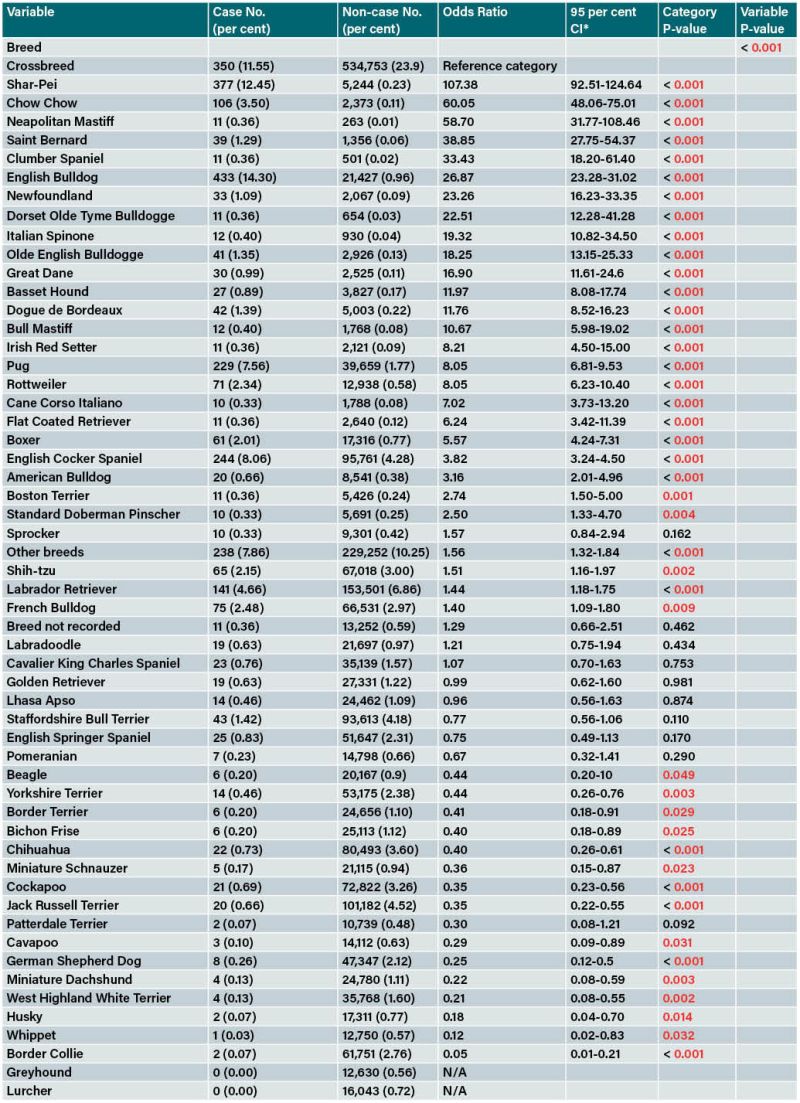
Table 1: Breed risk factors for conformational eyelid disorder cases overall during 2019 in dogs under primary veterinary care in the VetCompass Programme in the UK after accounting for confounding using multivariable logistic regression results. Column percentages shown in brackets. P-values < 0.050 are shown in red. *CI confidence interval.
Risk factor analysis
Risk factor results - conformational eyelid disorders overall
After accounting for the effects of the other variables evaluated in the multivariable modelling, 27 breeds showed increased odds ratio of conformational eyelid disorder compared with general crossbred dogs. The breeds with the highest odds ratios included Shar-Pei (odds ratio [OR] 107.38, 95 per cent CI 92.51-124.64, P < 0.001), Chow Chow (OR 60.05, 95 per cent CI 48.06-75.01, P < 0.001), and Neapolitan Mastiff (OR 58.7, 95 per cent CI 31.77-108.46, P < 0.001). Fifteen breeds showed reduced odds ratios of conformational eyelid disorder compared with general crossbreds. The breeds with the lowest odds ratios included: Border Collie (OR 0.05, 95 per cent CI 0.01-0.21, P < 0.001), Whippet (OR 0.12, 95 per cent CI 0.02-0.83, P = 0.032), and Husky (OR 0.18, 95 per cent CI 0.04-0.70, P = 0.014). No cases were detected in the Greyhound or Lurcher. (Table 1, page 565). Compared with general crossbred dogs, purebred dogs had 2.60 times higher odds ratio (95 per cent CI 2.32-2.91, P-value < 0.001) of conformational eyelid disorder. Kennel Club recognised breeds had 2.47 times the odds ratio compared to breeds not recognised by the Kennel Club (95 per cent CI 2.24-2.71, P < 0.001). Three Kennel Club breed groups (Working, Utility, and Gundog) showed higher odds ratio compared to breeds that were not recognised by the Kennel Club, while two breed groups showed lower odds ratio (Pastoral and Terrier). Breeds with brachycephalic skull conformation (OR 1.74, 95 per cent CI 1.61-1.89, P-value < 0.001) had higher odds ratio compared with breeds with mesocephalic skull conformation, while breeds with a dolichocephalic skull conformation had reduced odds ratio (OR 0.50, 95 per cent CI 0.42-0.49, P-value < 0.001). Compared to breeds with mild brachycephaly, breeds with moderate brachycephaly showed reduced odds ratio while breeds with severe brachycephaly showed increased odds ratio. There was a strong trend towards increasing odds ratio as the adult bodyweight increased. Breeds with erect ear carriage had the lowest odds ratio of conformational eyelid disorder. Compared with breeds with medium length coats, breeds with short coat had higher odds ratio and breeds with long coat had reduced odds ratio. Spaniel breeds overall had higher odds ratio of conformational eyelid disorder compared with crossbreed dogs (Table 2, page 568).

Table 2: Breed-related risk factors for conformational eyelid disorder cases overall during 2019 in dogs under primary veterinary care in the VetCompass Programme in the UK after accounting for confounding using multivariable logistic regression results. Column percentages shown in brackets. P-values < 0.050 are shown in red. *CI confidence interval.
Entropion
The 3,029 confirmed conformational eyelid disorder cases included 2,752 (90.86 per cent) entropion diagnoses. There were 67/3,029 (2.21 per cent) cases with both entropion and ectropion diagnoses. The annual prevalence for entropion in dogs overall was 0.33 per cent (95 per cent CI: 0.32-0.34). Breeds with the highest annual prevalence for entropion were Shar-Pei (15.41 per cent, 95 per cent CI 14.00-16.91), Chow Chow (9.28 per cent, 95 per cent CI 7.64-11.14), Neapolitan Mastiff (6.88 per cent, 95 per cent CI 3.02-13.14), Clumber Spaniel (6.34 per cent, 95 per cent CI 3.22-11.09), Saint Bernard (5.00 per cent, 95 per cent CI 3.44-6.99), and English Bulldog (4.65 per cent, 95 per cent CI 4.22-5.11).
Ectropion
Of the 3,029 confirmed conformational eyelid disorder cases, 344 (11.36 per cent) had an ectropion diagnosis. The annual prevalence for entropion in dogs overall was 0.04 per cent (95 per cent CI: 0.04-0.05). Breeds with the highest annual prevalence for ectropion were Neapolitan Mastiff (4.30 per cent, 95 per cent CI 1.41-9.77), Saint Bernard (1.72 per cent, 95 per cent CI 0.86-3.05), Basset Hound (1.59 per cent, 95 per cent CI 0.94-2.49), and Great Dane (1.47 per cent, 95 per cent CI 0.83-2.42).
Clinical management
Entropion
The median age at first recorded diagnosis with entropion was 2.02 years (IQR 0.69-5.15, range 0.02-16.99). Among 1,540 (67.69 per cent) entropion cases with at least one clinical sign recorded, the most common clinical signs were ocular discharge (n = 735, 47.73 per cent), epiphora (426, 27.79 per cent), blepharospasm (353, 22.92 per cent). At least one other ocular condition was recorded as comorbid with entropion in 1,019 (44.79 per cent) cases. Of these, the most common were conjunctivitis (414, 40.63 per cent), corneal ulceration (278, 27.28 per cent), and trichiasis (104, 10.21 per cent). Information on the clinical management plan at first diagnosis of entropion was recorded in 1906 (83.78 per cent) cases. Of these, the most common plans included medical care (1,133, 59.44 per cent) and surgery (1,098, 57.61 per cent). There was evidence in the available clinical records that surgical management was carried out for 414/2,275 (18.20 per cent) of the entropion cases. Of the 216 (52.17 per cent) surgical entropion cases with information available, the surgical methods used included Celsus-Hotz (86, 39.81 per cent), stay sutures (83, 38.43 per cent), and wedge resection (28, 12.96 per cent).
Ectropion
Among 303 of the 344 ectropion cases overall with age data available, the median age at first recorded diagnosis in all available EHRs was 2.15 years (IQR 0.69-6.90, range 0.16-14.94). Among 167 (65.75 per cent) of ectropion cases with at least one clinical sign recorded, the most common clinical signs were ocular discharge (n = 87, 52.10 per cent), conjunctival redness/hyperemia (46, 27.54 per cent), and epiphora (25, 14.97 per cent). At least one other ocular condition was recorded as comorbid with ectropion in 117 (38.36 per cent) cases. Of these, the most common were conjunctivitis (55, 31.07 per cent), diamond eye (17, 9.60 per cent), and corneal ulceration (16, 9.04 per cent). Information on the clinical management plan at first diagnosis of ectropion was recorded in 201 (65.90 per cent) cases. Of these, the most common plans included medical care (n = 121, 60.20 per cent) and surgery (65, 32.34 per cent) (S7 Table). There was evidence in the available clinical records that surgical management was carried out for 12/305 (3.93 per cent) of the ectropion cases. Of the eight (66.67 per cent) surgical ectropion cases with information available, the surgical methods used included wedge resection (n = 6, 75.00 per cent), Celsus-Hotz (2, 25.00 per cent), Stades forced granulation procedure (1, 12.50 per cent), and tarsorraphy (1, 12.50 per cent).
Discussion
In the current study, the annual prevalence of entropion diagnosis (0.33 per cent) was almost tenfold higher in comparison to ectropion (0.04 per cent). Of the conformational eyelid disorder cases with an accompanying clinical sign recorded, a striking 27 per cent of dogs with entropion and 9 per cent of ectropion cases were co-morbidly diagnosed with concurrent corneal ulceration, a painful and potentially globe-threatening condition that suggests a high welfare cost from conformational eyelid disorder9.
Shar Pei, Chow Chow, and Neapolitan Mastiff showed the highest breed annual prevalence for a conformational eyelid disorder overall. The breed-related odds ratios reported in the current study for conformational eyelid disorders were highly polarised, with odds ratios for many breeds either very high or very low in comparison to crossbreed dogs. The phenotype of the Husky is widely considered to have remained similar to the ancestral natural canine appearance18 and it is, therefore, noteworthy that the Husky featured among the breeds with the lowest odds ratio of conformational eyelid disorders in the current study. This supports the proposition for a close connection between conformational eyelid disorders and, indeed, other conformation-related disorders carrying severe impact on the welfare of the dog with common unnatural phenotypes such as brachycephaly or excessive skin folds selected by humanity during the invention of dog breeds19. It is also interesting to note that several breeds that also retain a more natural canine conformation, e.g., Greyhound, Border Collie, Whippet, had significantly lower odds ratio of conformational eyelid disorders than crossbreds.
Concurring with the current results showing concerningly high odds ratios for conformational eyelid disorders in the Shar Pei (OR 107.38) and Chow Chow (OR 60.05), the US ACVO Blue Book 2022 states that the frequency and form of entropion in Shar-Pei and Chow Chow is a particularly severe problem that has been recognised for decades. The UK Kennel Club breed standards state for every breed that “absolute soundness is essential” and that “breeders and judges should at all times be careful to avoid obvious conditions or exaggerations which would be detrimental in any way to the health, welfare, or soundness of this breed”20. This suggests that breeders, judges, and, indeed, the wider dog-acquiring public are normalising and celebrating this extreme conformation as a desirable phenotype in dogs. Given that the current legislation for commercial dog breeding in England states that “…no dog may be kept for breeding if it can reasonably be expected, on the basis of its genotype, phenotype or state of health that breeding from it could have a detrimental effect on its health or welfare or the health or welfare of its offspring”21, the current results suggest that many dogs in England are bred in breach of current legislation in several breeds.
The current data show brachycephalic dogs overall with an increased odds ratio for entropion (OR 1.83). This odds ratio was further exaggerated in the subset of those severely brachycephalic breeds. Previously, the probability of corneal ulceration has been strongly linked to the brachycephalic conformation and the existence of a nasal fold22,23, which are commonly interlinked conformational qualities in severely brachycephalic breeds such as Pekingese, Pug, Shih Tzu, and English Bulldog2, 22, 24-26. The popularity of brachycephalic breeds continues to grow; in 2019, 18 per cent of the dogs in UK were estimated to be brachycephalic, and 54 per cent of these severely brachycephalic11. With such a demographic shift, the conditions connected to conformation in these breeds and potential for pain and suffering associated with them cannot be over-emphasised.
Clinical diagnosis of conformational eyelid abnormality is usually straightforward for primary care practitioners but achieving the optimal surgical therapy necessary for some of the more complex cases may require specialist care2. However, the current data confirm that many cases of conformational eyelid disorder are managed completely under primary care, either with or without surgical therapy. Therefore, some previous studies based solely on referral data may have underestimated the overall prevalence of conformational eyelid disorders or may show referral bias towards the more complicated cases and associated breeds7,10, 27. On the other hand, even despite the large prevalence recorded, the current data may still have heavily underestimated the true prevalence. This is because normalisation of conformational eyelid disorders as “normal for breed” based on currently published breeding standards and breed norms may have led many owners and veterinarians to fail to include true cases not presenting with marked or disabling level of severity.
The impact of pain associated with conformational eyelid disorders is a key welfare issue. In the current study, a notable 27 per cent of dogs with entropion and 9 per cent of dogs with ectropion were co-morbidly diagnosed with corneal ulceration. Unless surgically managed, conformational eyelid disorders are typically chronic in nature and it is reasonable to assume that most of these dogs suffer from chronic pain, which in turn has been associated with changes in behavior, learning, and performance28.
In conclusion
Over six decades ago in 1963, S.F.J Hodgman talked about presumed hereditary defects in pedigree dogs and stated that “all the legislation in the world will not alone overcome this problem. There is no royal road to success, it is only attained by knowledge, perseverance, hard work and the courageous acceptance of many disappointments”29. The current results highlight that serious welfare issues of conformational eyelid disorders still exist in certain dog breeds and provide further evidence for brachycephalism and excessive skin fold as predisposing factors. Overall, it seems that there is still a long way to travel on the road to ensuring good innate health for all dogs.
- Bettenay S, Mueller RS, DJ. M. Diseases of the eyelids. In: Maggs DJ, Miller PE, R. O, editors. Slatter’s Fundamentals of Veterinary Ophthalmology. 6th ed: Elsevier Saunders; 2018. p. 127-57.
- Stades F, van der Woerdt A. Diseases and surgery of the canine eyelid. In: Gelatt KN, Ben-Shlomo G, Gilger BC, Hendrix DVH, Kern TJ, Plummer CE, editors. Veterinary Ophthalmology. 6th ed: John Wiley and Sons Inc; 2021. p. 935-42.
- Rubin LF. Inherited Eye Diseases in Purebred Dogs. Baltimore: Williams & Wilkins; 1989.
- Stades F, Boeve M, Van der Woerdt A. Palpebral fissure length in the dog and cat. Progress in Veterinary and Comparative Ophthalmology. 1992;2(4):155-61.
- ACVO. The Blue Book: Ocular Disorders Presumed to Be Inherited in Purebred Dogs. 14th ed. Ophthalmologists GCotACoV, editor. Meridian, ID: American College of Veterinary Ophthalmologists; 2022.
- Marfurt CF, Murphy CJ, Florczak JL. Morphology and neurochemistry of canine corneal innervation. Investigative Ophthalmology & Visual Science. 2001;42(10):2242-51.
- Lavallée G, Curto EM, Gratzek AT. Long-term success rate of entropion surgery is equivalent in juvenile and adult dogs. Journal of the American Veterinary Medical Association. 2023:1-5.
- Robertson B, Roberts S. Lateral canthus entropion in the dog, Part 2: Surgical correction. Results and follow-up from 21 cases. Veterinary and comparative ophthalmology (USA). 1995;5(3):162-9.
- Sanchez RF. Chapter 12: The Cornea. In: Gould D, McLellan GJ, editors. BSAVA manual of canine and feline ophthalmology. 3rd ed. London: BSAVA; 2014.
- Walter H, Bilotta T, Goncalves C, Busse C. A combination of modified Kuhnt–Szymanowski and Celsus–Hotz techniques for correction of entropion and overlong lower eyelids in dogs (40 eyes). Veterinary Ophthalmology. 2023;Early view(n/a).
- O’Neill DG, McMillan KM, Church DB, Brodbelt DC. Dog breeds and conformations in the UK in 2019: VetCompass canine demography and some consequent welfare implications. PLOS ONE. 2023;18(7):e0288081.
- ICECDogs. International Collaborative on Extreme Conformations in Dogs: International Partnership for Dogs; 2025 [Available from: https://www.icecdogs.com/.
- VetCompass. VetCompass Programme London: RVC Electronic Media Unit; 2025 [Available from: http://www.rvc.ac.uk/VetCOMPASS/.
- Coren S. What Shape Is Your Dog’s Ear? A richly illustrated glossary of dog ear shapes.: Psychology Today; 2012 [Available from: https://www.psychologytoday.com/gb/blog/canine-corner/201208/what-shape-is-your-dogs-ear.
- American Kennel Club. Dog Breeds: This is the official list of all American Kennel Club dog breeds.: AKC Global Services; 2024 [Available from: http://www.akc.org/breeds/index.cfm.
- The Kennel Club. Breed Information Centre: The Kennel Club Limited; 2025 [Available from: https://www.thekennelclub.org.uk/search/breeds-a-to-z.
- O’Neill DG, Lee YH, Brodbelt DC, Church DB, Pegram C, Halfacree Z. Reporting the epidemiology of aural haematoma in dogs and proposing a novel aetiopathogenetic pathway. Scientific Reports. 2021;11(1):21670.
- Thorsrud JA, Huson HJ. Description of breed ancestry and genetic health traits in arctic sled dog breeds. Canine Medicine and Genetics. 2021;8(1):8.
- Worboys M, Strange J-M, Pemberton N. The invention of the modern dog : breed and blood in Victorian Britain. 1st ed. Baltimore, Maryland, USA: Johns Hopkins University Press; 2018.
- The Kennel Club. Breed standards: The Kennel Club; 2025 [Available from: https://www.thekennelclub.org.uk/breed-standards/.
- LAGECDogs. Legal Advisory Group on Extreme Conformation in Dogs: A-LAW UK Centre for Animal Law; 2024 [Available from: https://www.alaw.org.uk/companion-animals/extreme-dog-conformation/.
- Packer RMA, Hendricks A, Burn CC. Impact of facial conformation on canine health: Corneal ulceration. PLoS ONE. 2015;10(5):1-16.
- O’Neill D, Lee MM, Brodbelt DC, Church DB, Sanchez RF. Corneal ulcerative disease in dogs under primary veterinary care in England: epidemiology and clinical management. Canine Genetics and Epidemiology. 2017;4(1):5.
- Krecny M, Tichy A, Rushton J, Nell B. A retrospective survey of ocular abnormalities in pugs: 130 cases. Journal of Small Animal Practice. 2015;56(2):96-102.
- O’Neill DG, Skipper A, Packer RMA, Lacey C, Brodbelt DC, Church DB, et al. English Bulldogs in the UK: a VetCompass study of their disorder predispositions and protections. Canine Medicine and Genetics. 2022;9(1):5.
- Sebbag L, Silva APSM, Santos ÁPB, Raposo ACS, Oriá AP. An eye on the Shih Tzu dog: Ophthalmic examination findings and ocular surface diagnostics. Veterinary Ophthalmology. 2023;26(S1):59-71.
- Bartlett PC, Van Buren JW, Neterer M, Zhou C. Disease surveillance and referral bias in the veterinary medical database. Preventive Veterinary Medicine. 2010;94(3-4):264-71.
- Mills DS, Demontigny-Bédard I, Gruen M, Klinck MP, McPeake KJ, Barcelos AM, et al. Pain and Problem Behavior in Cats and Dogs. Animals. 2020;10(2):318.
- Hodgman SFJ. Abnormalities and defects in pedigree dogs–I. An investigation into the existence of abnormalities in pedigree dogs in the British Isles. Journal of Small Animal Practice. 1963;4(6):447-56.
1. What is the presumed inheritance pattern for entropion and/or ectropion in dogs?
- Random occurrence
- Non-inherited
- Monogenic inheritance
- Polygenic inheritance
- The ‘mastiff’ gene
2. Why is extreme conformation in dogs called ‘extreme’?
- They are extremely popular on social media
- They are extremely cute to the public
- They lead to extremely high profits for breeders
- They give an extremely high chance of winning in dog shows
- They are extremely different from the natural dog conformation
3. Which dog breed has the highest predisposition to conformational eyelid disorders?
- Shar-Pei
- Chow Chow
- Neapolitan Mastiff
- Labrador Retriever
- English Bulldog
4. What percentage of entropion cases were comorbidly diagnosed with corneal ulceration?
- 7.28 per cent
- 17.28 per cent
- 27.28 per cent
- 37.28 per cent
- 47.28 per cent
5. Compared to mesocephalic dogs, what was the risk of conformational eyelid disorders for brachycephalic dogs?
- Lower
- The same
- Higher
- Zero risk in both types of dogs
- Not reported in the paper
ANSWERS: 1D; 2E; 3A; 4C; 5C.
